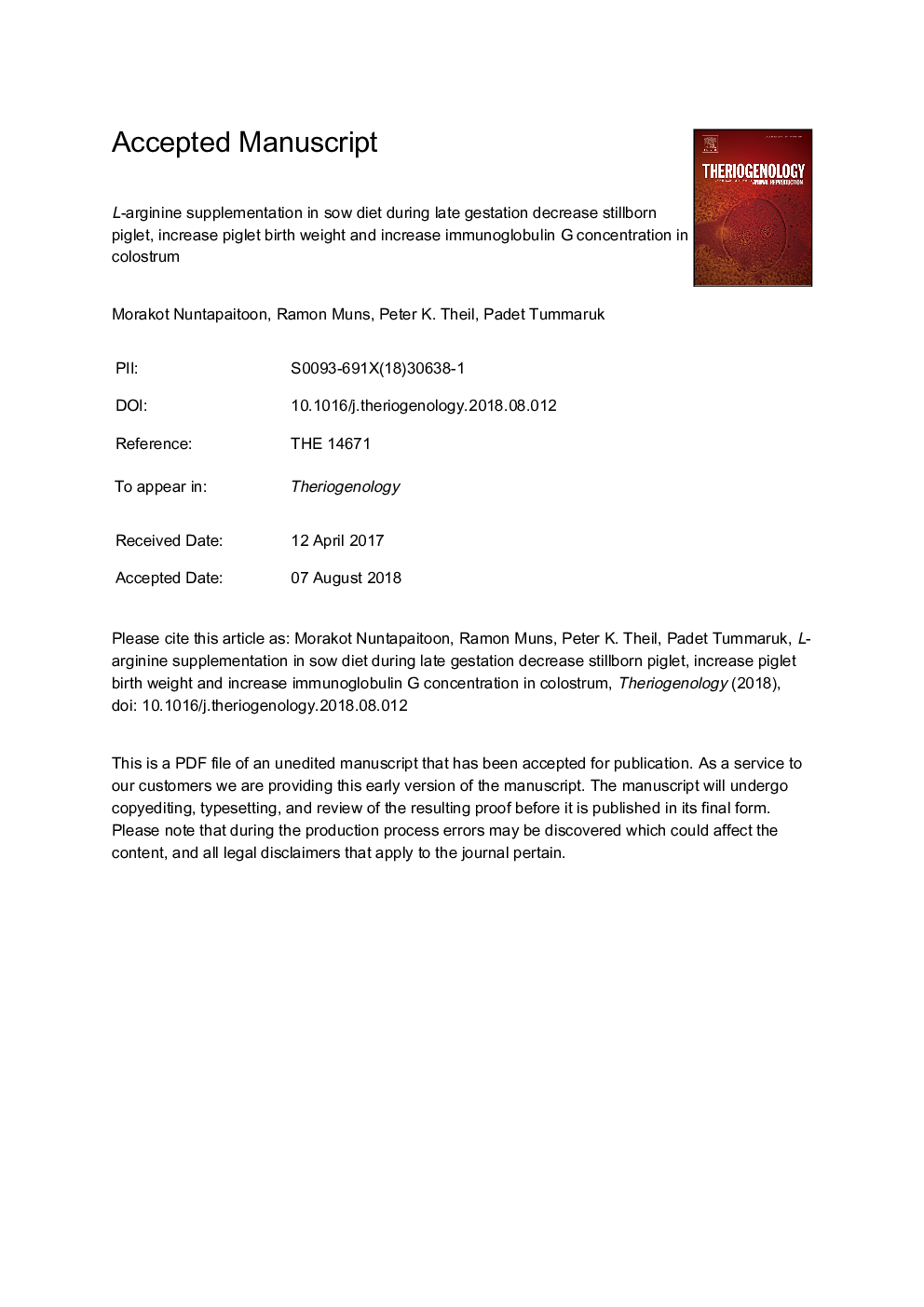| کد مقاله | کد نشریه | سال انتشار | مقاله انگلیسی | نسخه تمام متن |
|---|---|---|---|---|
| 8943816 | 1645208 | 2018 | 32 صفحه PDF | دانلود رایگان |
عنوان انگلیسی مقاله ISI
l-arginine supplementation in sow diet during late gestation decrease stillborn piglet, increase piglet birth weight and increase immunoglobulin G concentration in colostrum
دانلود مقاله + سفارش ترجمه
دانلود مقاله ISI انگلیسی
رایگان برای ایرانیان
کلمات کلیدی
موضوعات مرتبط
علوم زیستی و بیوفناوری
علوم کشاورزی و بیولوژیک
علوم دامی و جانورشناسی
پیش نمایش صفحه اول مقاله

چکیده انگلیسی
The fetal growth is rapid during the last trimester of gestation in sows and hence sow nutrition during this period is important for fetal growth and development. During the last decade, studies reported that l-arginine HCl supplementation during gestation increased sow and piglet performances. However, clinical studies concerning the association between l-arginine HCL supplementation and some neonatal piglet characteristics as well as colostrum and milk yield of sow are still lacking. The present study aims to determine the effect of l-arginine HCl supplementation in sow diet during late gestation on piglet characteristics at birth, colostrum consumption (CC), concentration of immunoglobulin G (IgG) in colostrum, milk yield, average daily gain at d 7 and 21 and piglet mortality at d 7 and 21 of life. In total, 166 sows were allocated into four groups, i.e., CON (nâ¯=â¯66), ARG-0.5 (nâ¯=â¯42), ARG-1.0 (nâ¯=â¯41) and ALA (nâ¯=â¯17). The sows in each group were fed with a conventional gestation diet (CON) or the same diet supplemented with 0.5% l-arginine HCl (ARG-0.5), 1.0% l-arginine HCl (ARG-1.0) or 1.7% l-alanine (ALA, isonitrogenous with ARG-1.0). The feeding protocol was carried out from 85 days of gestation until farrowing. The proportion of live-born piglets, piglet birth weight (BWB), within-litter variation of BWB, proportion of piglets with BWB above 1.35â¯kg, proportion of growth-restricted piglets (defined as BWB below 1.0â¯kg), blood oxygen saturation (SatO2) and heart rate were determined in 2292 newborn piglets from 166 litters. Colostrum consumption of each individual piglets and the colostral concentration of IgG was determined. The milk yield between d 0-7 and 7-21 and relative backfat loss were estimated in each individual sow. The piglet mortality and body weight was determined at d 7 and 21 of life. On average, the number of piglet born alive per litter was 12.4. The proportion of stillborn piglets, piglets with BWB above 1.35 kg and growth-restricted piglets were 6.9%, 62.7% and 14.0%, respectively. Piglet preweaning mortality at d 7 and 21 were 8.5% and 12.4%, respectively. Compared to the ALA group, ARG-0.5 increased the proportion of live-born piglets per litter (+9.8%, Pâ¯<â¯0.001), reduced stillborn (â8.3%, Pâ¯<â¯0.001) and tended to increase the proportion of piglets with BWB above 1.35 kg (+6.4%, Pâ¯=â¯0.08). Compared to the CON group, ARG-0.5 increased BWB (+7.0%, Pâ¯<â¯0.001), increased SatO2 (+3%, Pâ¯<â¯0.001) and reduced heart rate (â20%, Pâ¯<â¯0.001) and tended to reduce the relative backfat loss (â4.4%, Pâ¯=â¯0.06). No difference between ARG-1.0 and ARG-0.5 was observed among these traits. Other traits including within-litter variation of BWB, growth-restricted piglets, average daily gain, piglets preweaning mortality and CC and milk yield were not affected by treatment (Pâ¯>â¯0.05). The colostral concentration of IgG at 1â¯h after onset of farrowing in ARG-1.0 sows (116 mg/ml) was higher than CON, ARG-0.5 and ALA sows (85, 74 and 78â¯mg/ml, respectively; Pâ¯<â¯0.05). In conclusions, dietary l-arginine HCl supplementation in late gestating sows favourably increased proportion of live-born piglets, BWB, SatO2 and IgG concentration in the sow colostrum.
ناشر
Database: Elsevier - ScienceDirect (ساینس دایرکت)
Journal: Theriogenology - Volume 121, November 2018, Pages 27-34
Journal: Theriogenology - Volume 121, November 2018, Pages 27-34
نویسندگان
Morakot Nuntapaitoon, Ramon Muns, Peter K. Theil, Padet Tummaruk,